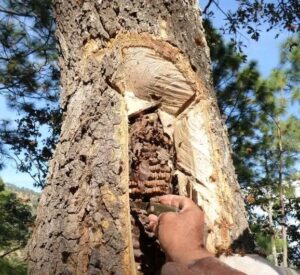
A resident harvesting honey in Tharaka Nithi | PHOTO-Dennis Mutua
By Dennis Mutua
Tharaka has been making headlines in recent days over scary deaths of locals resulting from honey which the region is known to produce. Patients taken ill over the honey mostly complain of stomach discomfort, vomiting, and diarrhoeic which occurs moments after one feeds on the honey.
However, what shocks locals is that for a long the honey has been safe and cases of death were not being experienced at all. For instance, while herding animals in the bushes, boys and also adults would normally harvest the honey from tree caves which they would feast on as they went about with their activities and nothing happened to them.
The same would happen with the usual bees’ honey which farmers would harvest for domestic consumption including preparing local brews and traditional medicines. Thus the issue of honey poisoning has come as a nightmare to Tharaka locals who for decades have lived to enjoy the sweet product from the land.
Worth noting, even after the occurrence of dozens of deaths in different parts of Tharaka constituency and Igambang’ombe Sub County, no report has been issued from the hospitals after their normal narratives of taking samples of the honey to government chemists.
This has made locals and especially kids continue feasting on the syrup once they spot it as no initiative has ever been taken to educate the community on what may be happening with the honey and how to figure out poisoned honey if indeed it is the issue.
Following the heightened cases, experts have however given their thoughts on the possible poisoning of the honey leading to the deaths. According to Meru Teaching and Referral Hospital CEO Dr. Joseph Wahome who spoke to the press said, wild honey can be contaminated by various components which may result to poisoning when consumed.
Dr. William Muraah another expert argued that depending on the plants that the bees harvest pollen from, some may be poisonous which makes their honey unfit for human consumption. Further Muraah stated that is possible for bees to devise a mechanism to put off enemies who may come along to harvest the honey and thus poisoning may turn out to be one of them.
He then argued that honey from bees is not usually meant for human food, but it is bees’ food and also they stock it for their young ones. His other angle of argument is the possibility of bees excreting substances that may not be harmful to them but on the other hand turn out to be poisonous to humans if consumed.
However, Alfonze Kamwara a respected senior elder in Tharaka has an interesting tale on honey.
Kamwara says that there exist 3 types of honey makers with normal stinging bees making safe syrup fit for human consumption.
The elder reveals that stinging bees honey has 3 contents, usually the usual syrup and two others known as mariana and nkinda in Kitharaka dialect, where the latter forms food for young bees. The second honey makers are small stingbees locally known as Ntomba and whose honey (Mpiri )Kamwara says is usually safe to be consumed.
Then there is Nchuura which manufactures honey known as Nthuura which he points out to be very risky owing to their tendency of sourcing honey ingredients from all sorts of trees indiscriminately.
He goes ahead to state that when the honey makers go around flowers looking for honey-making components, they usually carry preservable ones Nkinda and which acts as food for young ones in drought season on one wing.
The other wing then carries normal extracts from flowers that are used by the bees to make honey at their destinations. However unknown to many, the combination of the syrup and the solid components kept as food for young bees may be lethal when consumed, which Kamwara cites to be a possible factor in the poisoning in the Ncuura case.
“When the honey and Nkinda from Nchuura honey makers are taken in combination, the consumer is at a very high risk of poisoning which risks even death. Victims of the poisoning can only survive by taking plenty of fresh water to scale down the reaction,’’ he says.
Further, traditionally kids were not allowed to go around harvesting Ncuura honey as it was known for its poison . Nonetheless Kamwara told the Eastern that this has since been disregarded by the generation of the day who takes all types of honey to be fit for consumption.
Another elder Mzee Francis Mucheria told the Eastern that, unlike stinging bees, honey from Nchuura and Ntomba is a bit sour and has distinctive sweet tastes which distinguish it from normal honey. To prevent adverse cases of poisoning, Mzee Mucheria says traditionally adults would consume Nchuura in low amounts during drought seasons and then one would make sure sufficient water was available in case they exhibited signs of poisoning.
The two admitted that surging cases of the suspected poisoning have soiled the good reputation of Tharaka natural honey in the market but cautioned locals to cease harvesting honey from nchuura to avert more deaths.
However away from the narratives given, only the results of the samples collected can clearly shed light on what has been causing the numerous deaths after consuming the honey.




